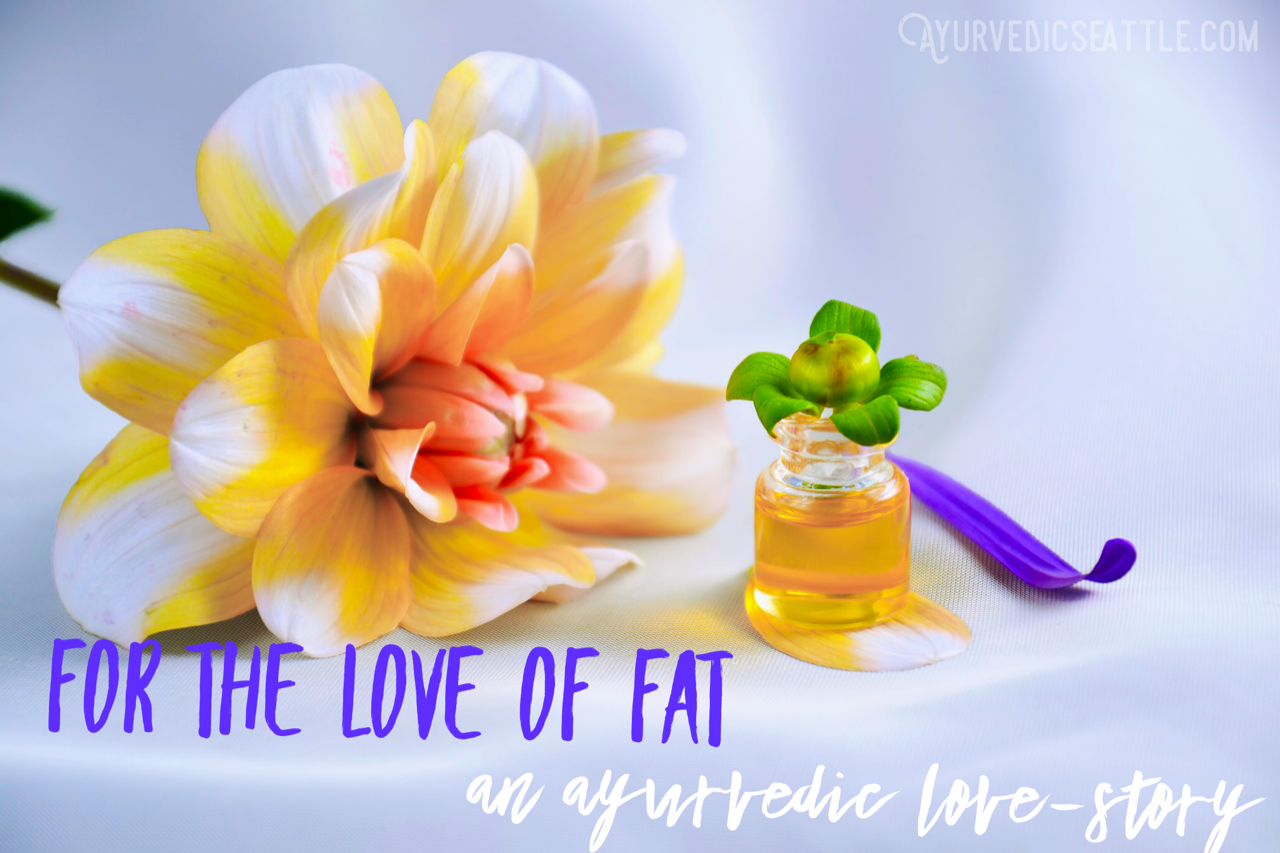The Ayurvedic Pharmacopoeia outlines hundreds of formulations that are based in form of herbal ghee, herbal oils and animal fats. These formulations are applied orally, through the skin, nose, ears, and even through vaginal and rectal enemas. This love affair with oils and fatty substances dates as far back as the history of Ayurveda.
Since these ancient times, Ayurveda has described oil application as a form of Snehana or love. As my teacher Dr. Jayarajan explains it, “Like love, oil is capable of transcending boundaries, it brings things together, heals wounds, it is nourishing, soothing and comforting, helps resolving conflict, bringing peace, etc.” Thus, the term Snehana is meant to remind us these powerful effects of oil application on the body.
Formulations with oil provide wide ranging therapeutic effects. These effects are based on the quality of oils themselves, but also by the herbs that the oils are combined with. Now, researchers observe these effects labs and clinical trials to develop similar technology for delivery of medicine.
Validating Ayurveda’s love for oils:
Transcending barriers: researchers have found that fatty acids can help improve absorption of medicine across mucus membranes including digestive tract1,2, as well as across skin3. Fatty acids also help to carry medicine across the blood-marrow and blood-brain barriers to these extremely hard to reach tissues of the body.4 Fatty acids can be used to deliver nervous system and marrow supportive herbs like Brahmi, Gotu Kola, Ashwagandha, and more.
Bringing things together, soothing and comforting: There is significant evidence that supports the beneficial effects of Omega-3, -6, and -9 fatty acid in supporting would healing.5 These fatty acids have been found to be effective reducing inflammation, building new blood vessels, improving transportation of nutrition into cells. Wide-range of studies have attributed similar wound healing, anti-aging, anti-inflammatory and anti-skin cancer effects on plant-based oils like olive oil, sesame oil, coconut oil, sunflower seed oil, and more.6
Nourishing: Fatty acids have proven to be effective allies in absorption of fat-soluble healing compounds from plants. In recent years, this knowledge has proven to be a game-changer in administration turmeric-based (curcumin) supplements – resulting in nearly double the absorption.7 Similar benefit is derived by combining fatty oils with hormone-balancing herbs like Ashwagandha, Shatavari, Gokhshura, and more.
Additionally, higher fat diet have been found to increase metabolic rate. Individuals burning more calories at rest compared to those eating low-fat diet over a 14 day period.8 This evidence supports the importance of including fats in our diet. Similarly, fatty tissue in the marrow has been to improve fat and energy metabolism.9 This further emphasizes the importance of ghee infused metabolic herbs used in Ayurvedic weight management and in management of metabolic diseases.
Ayurveda’s love for Ghee:
Ghee is a more widely known as clarified butter. One may have seen this product appear on the grocery store shelves in recent years, as the presence of Ayurveda has grown in the US. Among fatty acids, Ghee is rich in variety of fatty acids including triglycerides, saturated and polyunsaturated fats, and phospholipids. Altogether, this profile of fats make ghee an excellent delivery system for nutrients, including fat-soluble vitamins, as well as fat-soluble medicinal compounds from herbs.
Ayurveda uses ghee to deliver nourishment and medicinal benefit simultaneously. Ghee is applied to the skin, eyes, nose, in ears, ingested orally, vaginally, as well as given as enema through the rectum. Research has proven that healing benefits of milk-fats alone have anti-cancer, anti-microbial, anti-inflammatory, and immune-modulatory benefits.10
Therapeutic Routines:
Self-massage: applying a oil to the whole body a few times per week or just to hand, feet and crown of the head provide a nourishing and calming effect. It strengthens the skin against flaking and hair loss making is full and vibrant; gives calming and soothing feedback the nervous system to reduce stress; as well as support good quality sleep by balancing the Vata dosha.
Nasya: Nasal application of oil is to apply oils in the sinuses as well as provide a calming effect to the frontal lobe of the nervous system. Daily application of 2-3 drops is applied to coat the mucus membranes of the sinus, protecting them from infections and allergies. Penetration of the oil across the olfactory nerve passage provides a calming reflex to the frontal (cognitive) area of the brain. **this application must be learned under the guidance of a trained professional**
Oil and Ghee on meals: Putting 1-2 teaspoons of uncooked oil or ghee on each of your meals. Oil mixes with food ingredients like spices, mineral and vitamins to support absorption. It is also directly nourishing by helping build our fatty membranes, as well as serves as source of energy.
Cooking with oils: Using only high-smoke point oils is the only safe way to cook with oils. These are oils like Safflower, sunflower, Avocado and coconut oil. Oils must be cooked at low-to-medium temperature. Sautéing spices in oil helps infuse the essential oils of spices with cooking oil. Additionally, oil coats and penetrates our food with cooking process. This is a good way to making nutrients in our food more bio-available for absorption in to deep tissues like brain, marrow, and joints.
Conclusion:
Contrary our conventional education about effects of fats, there are a lot of benefit to using oils in our daily life. Beyond just dietary needs of the body, fats are delivery systems for fat-soluble nutrition and medicinal compounds. They penetrate every tissue of the body, therefore support in strengthening and anti-aging effects on every tissue on the body. Ayurvedic routines are meant to enhance intake of unheated oil, which is the best and safest form oil for the body’s energy and healing needs.
Clients are often perplexed with how much oil they are encouraged to apply and ingest, until they start seeing the healing benefit from prescribed herbal oils, herbal ghees, and daily routines for application that are curated for their personal health needs.
Reference:
Cano-Cebrian MJ, et al. “Intestinal Absorption Enhancement Via the Paracellular Route by Fatty Acids, Chitosans and Others: A Target for Drug Delivery.” Current Drug Delivery, 2005, 2, 9-22.
Hu Z, et al. “Molecular targeting of FATP4 transporter for oral delivery of therapeutic peptide.” Science Advances 01 Apr 2020: Vol. 6, no. 14, eaba0145
Bonina F, Puglia C. “Effect of Polyunsaturated Fatty Acids and Some Conventional Penetration Enhancers on Transdermal Delivery of Atenolol.” Drug Delivery Journal, 2008, Pg. 107-112.
Seelin A. “The Role of Size and Charge for Blood–Brain Barrier Permeation of Drugs and Fatty Acids. J Mol Neurosci (2007) 33:32–41.
Cardosos CRB, et al. “Influence of topical administration of n-3 and n-6 essential and n-9 nonessential fatty acids on the healing of cutaneous wounds.” Journal of Would Repair and Regeneration, March-April, 2004, Pg. 235-243.
Lin Tzu-Kai, et al. “Anti-Inflammatory and Skin Barrier Repair Effects of Topical Application of Some Plant Oils.” International Journal of Molecular Sciences, Dec. 2017.
Ochoa-Flores AA, et al. “Enhanced Bioavailability of Curcumin Nanoemulsions Stabilized with Phosphatidylcholine Modified with Medium Chain Fatty Acids.” Current Drug Delivery, 2017, 14, 377-385.
Van Marken Lichtenbelt WD, et al. “The effect of fat composition of the diet on energy metabolism.” Zeitschrift für Ernährungswissenschaft volume 36, pages303–305(1997).
Lecka-Czernik Beata “Marrow fat metabolism is linked to the systemic energy metabolism.” Bone. 2012 February ; 50(2): 534–539.
German B, et al. “Composition, Structure and Absorption of Milk Lipids: A Source of Energy, Fat-Soluble Nutrients and Bioactive Molecules.” Critical Reviews in Food Science and Nutrition 46(1):57-92 · February 2006.




